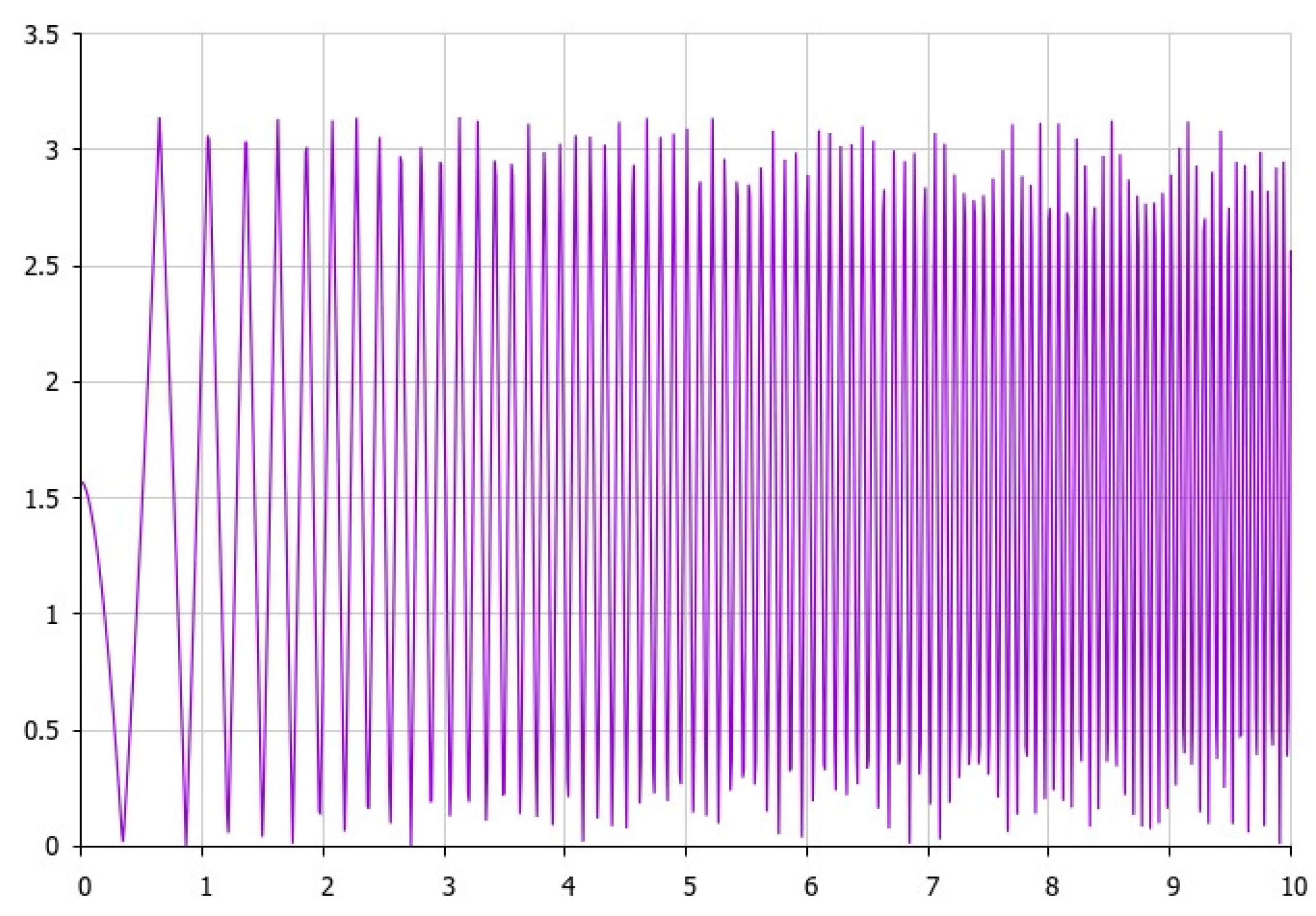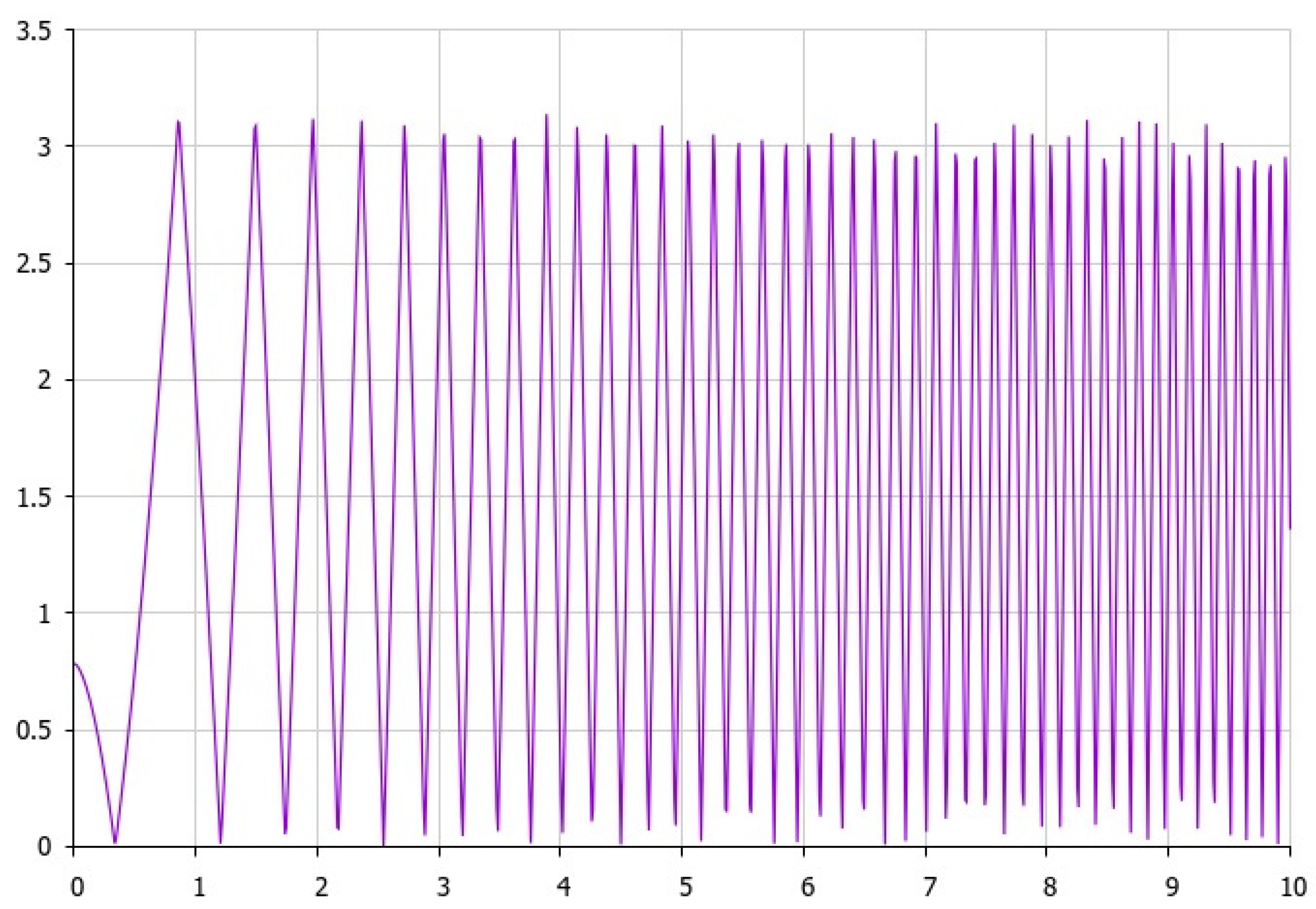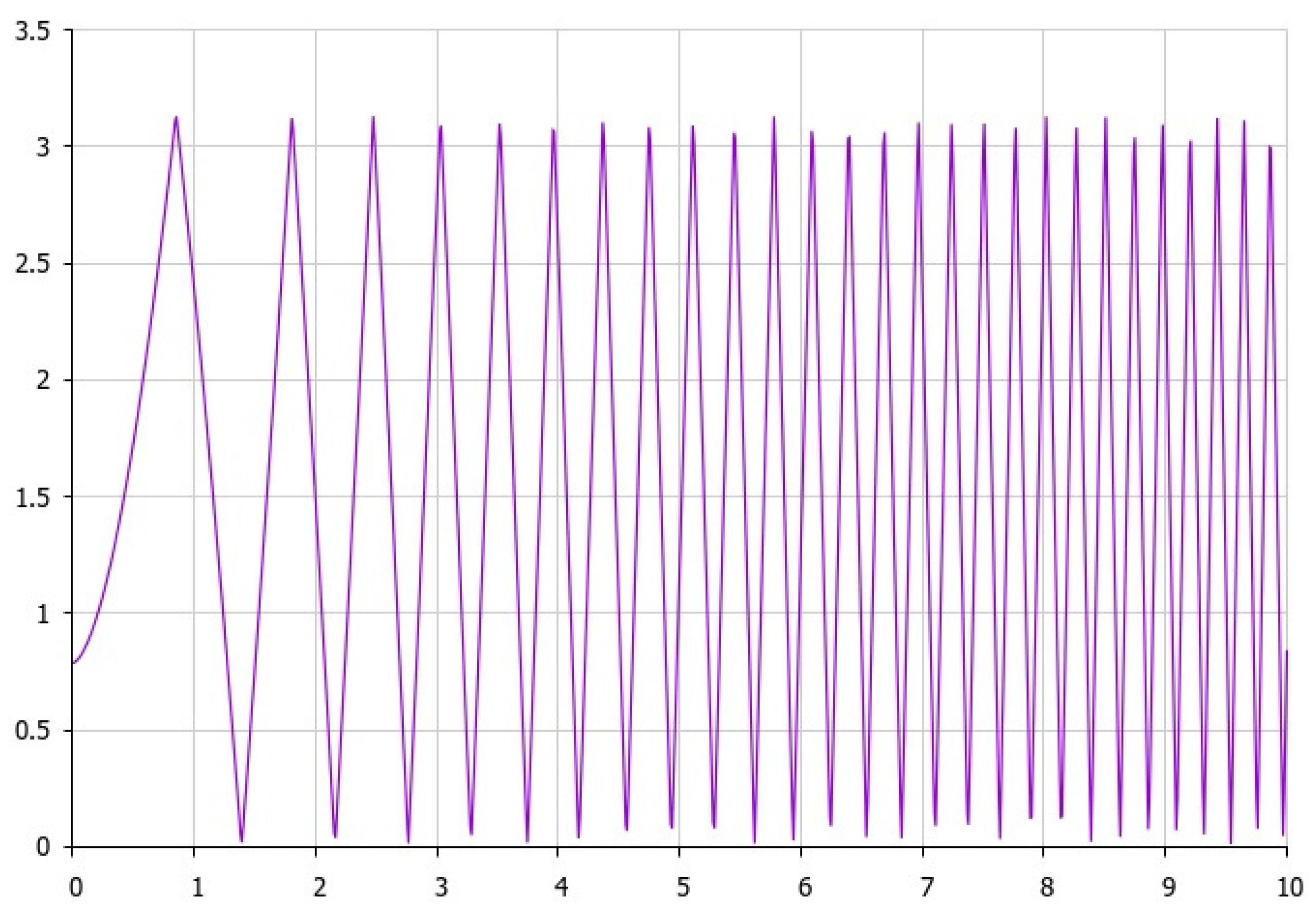On the Particular Dynamics of Rubble-Pile Asteroid Rotation Following Projectile Impact on the Surface During Planetary Approach
Abstract
1. Introduction
2. The System of Equations
3. Semi-Analytical Solution for Kinematic Equations (After Impact of Projectile on Surface)
- -
- First, the mass of the asteroid is decreased (6) (due to ejecting of ‘rubble-pile’ material after the impact by projectile) on the amount of the thrown ‘rubble-pile’ material into the outer space after collision (nevertheless, with further possible partial returning of it to the surface of asteroid).
- -
- Second, the component of angular velocity Ω1 should linearly increase as follows:
4. Semi-Analytical Solution of Euler’s Equations with Gravitational Torques (During Close Approach of Asteroid to Planet)
5. Discussion
6. Conclusions
7. Remarks (With Highlights)
- -
- A new physical model is suggested for asteroid rotation, consisting of two stages.
- -
- An asteroid with stable rotation about the maximal-inertia axis is struck by a projectile.
- -
- A projectile (much less massive than the asteroid) strikes it normally to the asteroid’s surface.
- -
- The second stage is governed by gravitational torques during the approach to the planet.
- -
- Gravitational torque-assisted energy dissipation reduces the kinetic energy of the asteroid’s spin.
- -
- The regime of rotation of Ω1 (with small components Ω2 and Ω3) is studied for both stages.
- -
- A semi-analytical ansatz is developed for modeling regimes of asteroid rotation.
- -
- The system of Euler equations for asteroid rotation has been investigated.
- -
- The asteroid experiences a regime of rotations with forced oscillations, which may disrupt it.
Funding
Data Availability Statement
Acknowledgments
Conflicts of Interest
References
- Ershkov, S.V. Semi-analytical Ansatz for Approximating Dynamics of Asteroid Rotation Approaching Planet. J. Appl. Comput. Mech. 2025, in press. [Google Scholar] [CrossRef]
- Ershkov, S.V.; Shamin, R.V. The dynamics of asteroid rotation, governed by YORP effect: The kinematic ansatz. Acta Astronaut. 2018, 149, 47–54. [Google Scholar] [CrossRef]
- Ershkov, S.V.; Leshchenko, D. On the dynamics OF NON-RIGID asteroid rotation. Acta Astronaut. 2019, 161, 40–43. [Google Scholar] [CrossRef]
- Walsh, K.J. Rubble pile asteroids. Annu. Rev. Astron. Astrophys. 2018, 56, 593–624. [Google Scholar] [CrossRef]
- Chapman, C.R.; Morrison, D.; Zellner, B. Surface properties of asteroids: A synthesis of polarimetry, radiometry, and spectrophotometry. Icarus 1975, 25, 104–130. [Google Scholar] [CrossRef]
- Kartashov, E.M. Developing generalized model representations of thermal shock for local non-equilibrium heat transfer processes. Russ. Technol. J. 2023, 11, 70–85. [Google Scholar] [CrossRef]
- Melnikov, A.V. Rotational Dynamics of Asteroids Approaching Planets. Sol. Syst. Res. 2022, 56, 241–251. [Google Scholar] [CrossRef]
- Lobanova, K.S.; Melnikov, A.V. Disturbances in the Rotational Dynamics of Asteroid (99942) Apophis at its Approach to the Earth in 2029. Sol. Syst. Res. 2024, 58, 208–219. [Google Scholar] [CrossRef]
- Ershkov, S.; Leshchenko, D. Inelastic Collision Influencing the Rotational Dynamics of a Non-Rigid Asteroid (of Rubble Pile Type). Mathematics 2023, 11, 1491. [Google Scholar] [CrossRef]
- de Goede, T.C.; de Bruin, K.G.; Bonn, D. High-velocity impact of solid objects on non-Newtonian fluids. Sci. Rep. 2019, 9, 1250. [Google Scholar] [CrossRef]
- Waitukaitis, S.R.; Jaeger, H.M. Impact-activated solidification of dense suspensions via dynamic jamming fronts. Nature 2012, 487, 205–209. [Google Scholar] [CrossRef]
- Ershkov, S.; Leshchenko, D.; Rachinskaya, A. Note on the trapped motion in ER3BP at the vicinity of barycenter. Arch. Appl. Mech. 2021, 91, 997–1005. [Google Scholar] [CrossRef]
- Walsh, K.J.; Richardson, D.C.; Michel, P. Spin-up of rubble-pile asteroids: Disruption, satellite formation, and equilibrium shapes. Icarus 2012, 220, 514–529. [Google Scholar] [CrossRef]
- Melnikov, A.V.; Shevchenko, I.I. Unusual rotation modes of minor planetary satellites. Sol. Syst. Res. 2007, 41, 483–491. [Google Scholar] [CrossRef]
- Melnikov, A.V. Resonant and Chaotic Phenomena in the Dynamics of Celestial Bodies; GAO Pulkovo Observatory: Saint Petersburg, Russia, 2016. [Google Scholar]
- Vokrouhlicky, D.; Bottke, W.F.; Chesley, S.R.; Scheeres, D.J.; Statler, T.S. The Yarkovsky and YORP Effects. arXiv 2015, arXiv:1502.01249. [Google Scholar] [CrossRef]
- Chernous’ko, F.L. On the Motion of a Satellite about Its Center of Mass under the Action of Gravitational Torques. Prikl. Mat. Mekh. 1963, 27, 474–483. (In Russian) [Google Scholar]
- Chernousko, F.L.; Akulenko, L.D.; Leshchenko, D.D. Evolution of Motions of a Rigid Body About Its Center of Mass; Springer: Cham, Switzerland, 2017. [Google Scholar]
- Beletsky, V.V. Motion of an Artificial Satellite About Its Center of Mass; Israel Program for Scientific Translation: Jerusalem, Israel, 1966. [Google Scholar]
- Benson, C.J.; Scheeres, D.J.; Brozović, M.; Chesley, S.R.; Pravec, P.; Scheirich, P. Spin state evolution of (99942) Apophis during its 2029 Earth encounter. Icarus 2023, 390, 115324. [Google Scholar] [CrossRef]
- Souchay, J.; Lhotka, C.; Heron, G.; Herve, Y.; Puente, V.; Lopez, M.F. Changes of spin axis and rate of the asteroid (99942) Apophis during the 2029 close encounter with Earth: A constrained model. Astron. Astrophys. 2018, 617, A74. [Google Scholar] [CrossRef]
- Holsapple, K.A.; Michel, P. Tidal disruptions: A continuum theory for solid bodies. Icarus 2006, 183, 331–348. [Google Scholar] [CrossRef]
- Hirabayashi, M.; Kim, Y.; Brozović, M. Finite element modeling to characterize the stress evolution in asteroid (99942) Apophis during the 2029 Earth encounter. Icarus 2021, 365, 114493. [Google Scholar] [CrossRef]
- Kartashov, E.M. Model representations of heat shock in terms of dynamic thermal elasticity. Russ. Technol. J. 2020, 8, 85–108. (In Russian) [Google Scholar] [CrossRef]
- Deriglazov, A.A. Rigid Body as a Constrained System: Lagrangian and Hamiltonian Formalism; Cambridge Scholars Publishing: Newcastle upon Tyne, UK, 2024. [Google Scholar]
- Klavetter, J.J. Rotation of Hyperion. 2. Dynamics. Astron. J. 1989, 98, 1855. [Google Scholar] [CrossRef]
- Wisdom, J.; Peale, S.J.; Mignard, F. The chaotic rotation of Hyperion. Icarus 1984, 58, 137–152. [Google Scholar] [CrossRef]
- Pravec, P.; Harris, A.W.; Michalowski, T. Asteroid rotations. In Asteroids III; Bottke, W.F., Jr., Cellino, A., Paolicchi, P., Binzel, R.P., Eds.; University of Arizona Press: Tucson, AL, USA, 2002; pp. 113–122. [Google Scholar]
- Scheeres, D.J. Orbital Motion in Strongly Perturbed Environments; Applications to Asteroid, Comet and Planetary Satellite Orbiters; Springer: Berlin/Heidelberg, Germany; Praxis Publishing: Chichester, UK, 2012. [Google Scholar]
- Szebehely, V. Theory of Orbits. The Restricted Problem of Three Bodies; Yale University: New Haven, CT, USA; Academic Press: New York, NY, USA; London, UK, 1967. [Google Scholar]
- Landau, L.D.; Lifshitz, E.M. Course of Theoretical Physics, Mechanics, 3rd ed.; §37 (“The Asymmetrical Top”); Heinemann, B., Ed.; Linacre House: Oxford, UK, 1976; Volume 1. [Google Scholar]
- Deriglazov, A.A. Lagrangian and Hamiltonian formulations of asymmetric rigid body, considered as a constrained system. Eur. J. Phys. 2023, 44, 065001. [Google Scholar] [CrossRef]
- Amer, T.S.; Elneklawy, A.H.; El-Kafly, H.F. Dynamical motion of a spacecraft containing a slug and influenced by a gyrostatic moment and constant torques. J. Low Freq. Noise Vib. Act. Control 2025, 44, 1708–1725. [Google Scholar] [CrossRef]
- Rivkin, A.S.; Cheng, A.F. Planetary defense with the Double Asteroid Redirection Test (DART) mission and prospects. Nat. Commun. 2023, 14, 1003. [Google Scholar] [CrossRef]
- Ballouz, R.-L.; Walsh, K.J.; Sánchez, P.; Holsapple, K.A.; Michel, P.; Scheeres, D.J.; Zhang, Y.; Richardson, D.C.; Barnouin, O.S.; Nolan, M.C.; et al. Modified granular impact force laws for the OSIRIS-REx touchdown on the surface of asteroid (101955) Bennu. Mon. Not. R. Astron. Soc. 2021, 507, 5087–5105. [Google Scholar] [CrossRef]
- Sánchez, P.; Scheeres, D.J. Dynamics of a granular asteroid after a subsonic DART-like impact. Icarus 2025, 442, 116741. [Google Scholar] [CrossRef]
- Stickle, A.M.; Kumamoto, K.M.; Graninger, D.M.; DeCoster, M.E.; Caldwell, W.K.; Pearl, J.M.; Owen, J.M.; Barnouin, O.; Collins, G.S.; Daly, R.T.; et al. Dimorphos’s Material Properties and Estimates of Crater Size from the DART Impact. Planet. Sci. J. 2025, 6, 38. [Google Scholar] [CrossRef]
- Trógolo, N.; Bagatin, A.C.; Parro, L.M.; Leiva, A.M.; Moreno, F.; Millas, C.; Benavidez, P.G. Evolution of ejecta in the (65803) Didymos system driven by the fast-spin primary-Stability conditions, mass transfer, and orbiting disk. Astron. Astrophys. 2025, 700, A164. [Google Scholar] [CrossRef]
- Naidu, S.P.; Chesley, S.R.; Moskovitz, N.; Thomas, C.; Meyer, A.J.; Pravec, P.; Scheirich, P.; Farnocchia, D.; Scheeres, D.J.; Brozovic, M.; et al. Orbital and Physical Characterization of Asteroid Dimorphos Following the DART Impact. Planet. Sci. J. 2024, 5, 74. [Google Scholar] [CrossRef]
- Chabot, N.; Adams, E.; Rivkin, A.; Kalirai, J. DART: Latest results from the Dimorphos impact and a look forward to future planetary defense initiatives. Acta Astronaut. 2024, 220, 118–125. [Google Scholar] [CrossRef]
- Liu, W.; Zhang, Q.; Long, R.; Ren, J.; Li, J.; Gong, Z.; Wu, Q.; Ren, S. Experimental and Numerical Simulation of Ejecta Size and Velocity of Hypervelocity Impact Rubble-Pile Asteroid. Aerospace 2024, 11, 621. [Google Scholar] [CrossRef]
- Akulenko, L.; Leshchenko, D.; Kushpil, T.; Timoshenko, I. Problems of Evolution of Rotations of a Rigid Body under the Action of Perturbing Moments. Multibody Syst. Dyn. 2001, 6, 3–16. [Google Scholar] [CrossRef]



Disclaimer/Publisher’s Note: The statements, opinions and data contained in all publications are solely those of the individual author(s) and contributor(s) and not of MDPI and/or the editor(s). MDPI and/or the editor(s) disclaim responsibility for any injury to people or property resulting from any ideas, methods, instructions or products referred to in the content. |
© 2025 by the author. Licensee MDPI, Basel, Switzerland. This article is an open access article distributed under the terms and conditions of the Creative Commons Attribution (CC BY) license (https://creativecommons.org/licenses/by/4.0/).
Share and Cite
Ershkov, S. On the Particular Dynamics of Rubble-Pile Asteroid Rotation Following Projectile Impact on the Surface During Planetary Approach. Mathematics 2025, 13, 3412. https://doi.org/10.3390/math13213412
Ershkov S. On the Particular Dynamics of Rubble-Pile Asteroid Rotation Following Projectile Impact on the Surface During Planetary Approach. Mathematics. 2025; 13(21):3412. https://doi.org/10.3390/math13213412
Chicago/Turabian StyleErshkov, Sergey. 2025. "On the Particular Dynamics of Rubble-Pile Asteroid Rotation Following Projectile Impact on the Surface During Planetary Approach" Mathematics 13, no. 21: 3412. https://doi.org/10.3390/math13213412
APA StyleErshkov, S. (2025). On the Particular Dynamics of Rubble-Pile Asteroid Rotation Following Projectile Impact on the Surface During Planetary Approach. Mathematics, 13(21), 3412. https://doi.org/10.3390/math13213412





